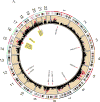Family-specific aggregation of lipid GWAS variants confers the susceptibility to familial hypercholesterolemia in a large Austrian family
- PMID: 28772107
- PMCID: PMC5698088
- DOI: 10.1016/j.atherosclerosis.2017.07.024
Family-specific aggregation of lipid GWAS variants confers the susceptibility to familial hypercholesterolemia in a large Austrian family
Abstract
Background and aims: Hypercholesterolemia confers susceptibility to cardiovascular disease (CVD). Both serum total cholesterol (TC) and LDL-cholesterol (LDL-C) exhibit a strong genetic component (heritability estimates 0.41-0.50). However, a large part of this heritability cannot be explained by the variants identified in recent extensive genome-wide association studies (GWAS) on lipids. Our aim was to find genetic causes leading to high LDL-C levels and ultimately CVD in a large Austrian family presenting with what appears to be autosomal dominant inheritance for familial hypercholesterolemia (FH).
Methods: We utilized linkage analysis followed by whole-exome sequencing and genetic risk score analysis using an Austrian multi-generational family with various dyslipidemias, including elevated TC and LDL-C, and one family branch with elevated lipoprotein (a) (Lp(a)).
Results: We did not find evidence for genome-wide significant linkage for LDL-C or apparent causative variants in the known FH genes rather, we discovered a particular family-specific combination of nine GWAS LDL-C SNPs (p = 0.02 by permutation), and putative less severe familial hypercholesterolemia mutations in the LDLR and APOB genes in a subset of the affected family members. Separately, high Lp(a) levels observed in one branch of the family were explained primarily by the LPA locus, including short (<23) Kringle IV repeats and rs3798220.
Conclusions: Taken together, some forms of FH may be explained by family-specific combinations of LDL-C GWAS SNPs.
Keywords: Familial hypercholesterolemia (FH); Genetic risk score (GRS); LDL cholesterol; Lipoprotein (a).
Copyright © 2017 Elsevier B.V. All rights reserved.
Conflict of interest statement
The authors declared they do not have anything to disclose regarding conflict of interest with respect to this manuscript.
Figures



References
-
- Mendis S, Puska P, Norrving B. Global atlas on cardiovascular disease prevention and control. World Heal Organ. 2011:2–14.
-
- Fischer M, Broeckel U, Holmer S, Baessler A, Hengstenberg C, et al. Distinct heritable patterns of angiographic coronary artery disease in families with myocardial infarction. Circulation. 2005;111(7):855–62. doi: 10.1161/01.CIR.0000155611.41961.BB. - DOI - PubMed
-
- Zdravkovic S, Wienke A, Pedersen NL, Marenberg ME, Yashin AI, De Faire U. Heritability of death from coronary heart disease: A 36-year follow-up of 20 966 Swedish twins. J Intern Med. 2002;252(3):247–54. - PubMed
-
- Santos RD, Gidding SS, Hegele RA, Cuchel MA, Barter PJ, et al. Defining severe familial hypercholesterolaemia and the implications for clinical management: a consensus statement from the International Atherosclerosis Society Severe Familial Hypercholesterolemia Panel. Lancet Diabetes Endocrinol. Elsevier Ltd. 2016;8587(16):19–21. doi: 10.1016/S2213-8587(16)30041-9. - DOI - PubMed
MeSH terms
Substances
Grants and funding
LinkOut - more resources
Full Text Sources
Other Literature Sources
Medical
Miscellaneous

